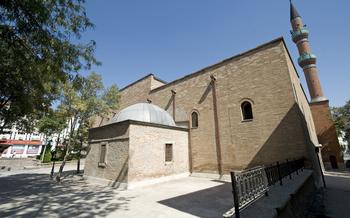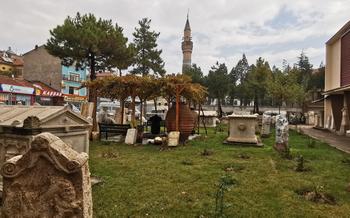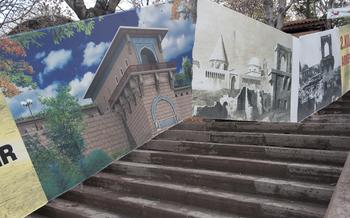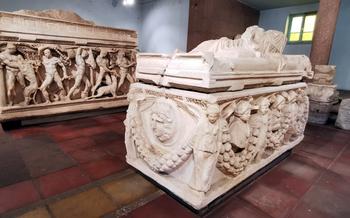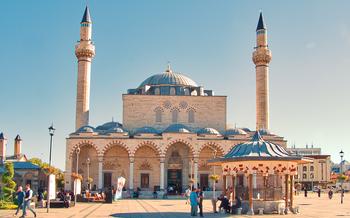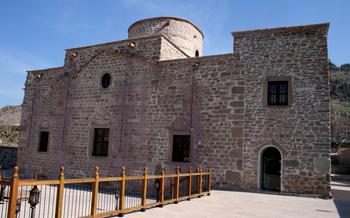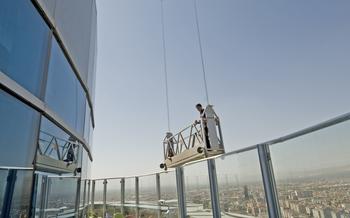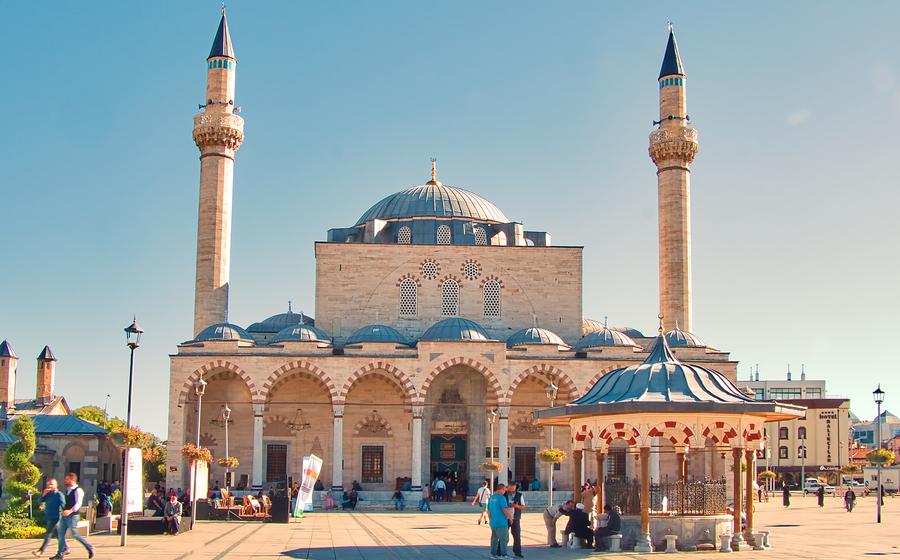
St. Pavlos Catholic Church
- St. Pavlos Catholic Church: A Historical Gem in Konya
- Location and Accessibility
- History of the Church
- Architectural Highlights of St. Pavlos Catholic Church
- Religious Significance
- Interior Features of St. Pavlos Catholic Church
- Services and Mass Schedule
- Cultural and Social Significance
- Visiting Tips
- Nearby Attractions
- Events and Festivals
- Historical Context of Konya
- Konya's Transformation Over Time
- Local Cuisine and Hospitality
- Photography Tips:
- Insider Tip: Unveiling Hidden Gems and Local Secrets
St. Pavlos Catholic Church: A Historical Gem in Konya
Nestled in the heart of Konya, Turkey, the St. Pavlos Catholic Church stands as a testament to the city's rich history and religious diversity. Built in the late 19th century, this magnificent structure is a living symbol of tolerance and coexistence, blending Gothic Revival architecture with local influences to create a unique and awe-inspiring edifice.
The church holds immense significance for Christians, serving as a sacred place of worship and pilgrimage. Its construction marked a turning point in Konya's religious landscape, representing the growing presence and acceptance of Christianity in a predominantly Muslim region. Embodying the spirit of interfaith dialogue and understanding, the St. Pavlos Catholic Church stands as a symbol of harmony and mutual respect among different faiths.
Location and Accessibility
The St. Pavlos Catholic Church is situated in the heart of Konya, on the corner of İbrahim Hakkı Caddesi and Kadınlar Pazarı Sokak. It is conveniently located within walking distance of several other notable landmarks, including the Alaeddin Mosque, Mevlana Museum, and the Konya Archaeological Museum. Visitors can easily reach the church by taking a short stroll from any of these attractions.
For those arriving by public transport, the church is well-served by local bus routes. The nearest bus stop, called "İbrahim Hakkı Caddesi," is located just a few steps away from the church entrance. Alternatively, visitors can take a taxi or ride-sharing service from the Konya city center, which typically takes around 10-15 minutes.
Limited parking is available on the side streets surrounding the church, but it is advisable to arrive early to secure a spot. Visitors should be mindful of the local parking regulations and avoid blocking driveways or intersections.
History of the Church
St. Pavlos Catholic Church, a testament to the enduring spirit of Christianity in Konya, traces its origins back to the 19th century. Its construction, initiated in 1861, reflects the growing presence of the Catholic community in the city. The church's foundation is closely intertwined with the missionary work of St. Paul, who played a pivotal role in spreading Christianity in the region. Dedicated to St. Paul, the church stands as a symbol of the early Christian presence in Konya. Despite the challenges faced by the Christian community over the centuries, the church has undergone meticulous preservation and restoration efforts, ensuring its architectural integrity and continued significance as a place of worship and pilgrimage.
Architectural Highlights of St. Pavlos Catholic Church
The St. Pavlos Catholic Church, constructed in the Gothic Revival style, stands out for its architectural grandeur and unique features. Its facade is characterized by intricate stone carvings, pointed arches, and a rose window that floods the interior with natural light. The church's tall steeple, a prominent landmark in Konya's skyline, is a testament to its architectural significance.
Inside, the church's Gothic design is evident in its vaulted ceilings, ribbed arches, and stained glass windows. The stained glass windows, depicting scenes from the Bible, are particularly noteworthy for their vibrant colors and intricate artistry. They add a touch of ethereal beauty to the church's interior and create a sense of awe and inspiration.
While the St. Pavlos Catholic Church shares similarities with other Gothic churches in Europe, it also incorporates elements of local architectural traditions. The use of stone and brick, common in Anatolian architecture, blends seamlessly with the Gothic design, creating a unique and harmonious aesthetic. The result is a church that is both rooted in its local context and reflective of its Christian heritage.
Religious Significance
The St. Pavlos Catholic Church holds immense religious significance for the local Catholic community. It serves as a spiritual haven for Christians in a predominantly Muslim city, offering a place of worship, prayer, and fellowship. The church is a testament to the presence and resilience of the Christian faith in Konya, despite its minority status.
For many local Catholics, the church is a source of comfort, guidance, and spiritual nourishment. They gather here to celebrate mass, receive sacraments, and participate in various religious activities. The church also organizes special services during holidays and festivals, which attract a large number of devotees.
Beyond its local significance, the St. Pavlos Catholic Church is also a symbol of interfaith dialogue and understanding. It stands as a reminder of the peaceful coexistence and mutual respect between different religious communities in Konya. The church actively promotes interfaith initiatives, fostering dialogue and cooperation among people of different faiths.
The presence of a Catholic church in the heart of Konya, a city known for its Islamic heritage, is a testament to the tolerance and coexistence that have characterized the city throughout its history. The St. Pavlos Catholic Church is a living example of how different religions can coexist and enrich each other, creating a vibrant and diverse religious landscape.
Interior Features of St. Pavlos Catholic Church
The interior of St. Pavlos Catholic Church is a testament to its rich history and religious significance. The altar, adorned with intricate carvings and a golden tabernacle, stands as the focal point of the church. The stained glass windows, with their vibrant colors and religious symbolism, create a breathtaking spectacle, casting a warm glow on the interior. Statues of saints, paintings depicting biblical scenes, and other artwork adorn the walls, adding to the church's aesthetic appeal. Among the most notable artifacts is a relic of St. Paul, which is displayed in a special reliquary, attracting pilgrims and believers from around the world.
Services and Mass Schedule
St. Pavlos Catholic Church offers regular mass services in various languages to cater to the diverse congregation. Mass timings may vary depending on the day of the week and special occasions. It is advisable to check the church's website or contact the parish office for the most up-to-date schedule.
During major holidays and festivals, such as Christmas and Easter, special masses and services are held with elaborate decorations and rituals. These events attract a large number of worshippers and visitors, creating a vibrant and festive atmosphere.
For inquiries regarding mass schedules, reservations, or any other assistance, visitors can reach out to the church office through the provided contact information. It is important to adhere to the dress code and etiquette guidelines while visiting the church to maintain a respectful and sacred environment.
Cultural and Social Significance
St. Pavlos Catholic Church serves as a hub for cultural exchange and community engagement in Konya. It plays a pivotal role in promoting interfaith dialogue and understanding among people of different religious backgrounds. The church regularly hosts events and gatherings that bring together locals and visitors, fostering a sense of community and belonging. These initiatives include charity events, cultural exhibitions, and interfaith discussions, which aim to bridge gaps and build bridges of understanding.
The church's cultural significance extends beyond its religious function. It serves as a venue for various cultural events, such as concerts, art exhibitions, and workshops. These events provide a platform for local artists and performers to showcase their talents, while also engaging the wider community in diverse cultural expressions. By fostering an environment of cultural exchange and understanding, St. Pavlos Catholic Church contributes to the vibrant cultural landscape of Konya.
Visiting Tips
-
For optimal lighting conditions and fewer crowds, plan your visit in the morning or late afternoon.
-
Guided tours are available upon request, providing insights into the church's history, architecture, and religious significance. Self-guided exploration is also encouraged, allowing visitors to discover the church's unique features at their own pace.
-
When visiting a religious site, appropriate attire and behavior are essential. Modest clothing that covers the shoulders and knees is recommended, and visitors should be respectful of the ongoing religious services or ceremonies.
-
Photography is permitted within the church, but using flash or tripods is prohibited. Visitors should be mindful of the privacy of others and avoid taking photos during religious services.
Nearby Attractions
St. Pavlos Catholic Church is situated in the heart of Konya, surrounded by a treasure trove of historical, cultural, and religious landmarks. A short walk from the church, visitors can explore the magnificent Mevlana Museum, the final resting place of the renowned Sufi mystic Rumi. The museum houses Rumi's tomb, as well as exhibits showcasing his life, teachings, and the Whirling Dervishes' mystical dance ceremony.
Just a stone's throw away is the Alaeddin Mosque, an architectural masterpiece that stands as a testament to Konya's rich Islamic heritage. With its awe-inspiring dome, intricate tilework, and soaring minarets, the mosque is a must-see for history and architecture enthusiasts.
For a taste of local culture, visitors can delve into the vibrant Konya Bazaar, a bustling marketplace where vendors display an array of traditional Turkish handicrafts, carpets, jewelry, and delectable treats. Haggling is not only acceptable but expected, adding an element of excitement to the shopping experience.
After a day of exploration, indulge in the flavors of Turkish cuisine at one of the many restaurants near the church. Savor the aromatic kebabs, succulent pide (Turkish pizza), and mouthwatering Turkish delights, accompanied by a refreshing glass of çay (Turkish tea).
Events and Festivals
St. Pavlos Catholic Church is not only a place of worship but also a vibrant center for cultural and community events. Throughout the year, the church hosts various celebrations and festivals that attract both locals and visitors.
One of the most significant events is the annual feast day of St. Paul, celebrated on June 29th. The church organizes a grand mass followed by a procession through the streets of Konya, attracting thousands of devotees. During this time, the church is adorned with colorful decorations, and a festive atmosphere fills the air.
Other religious holidays, such as Christmas, Easter, and Lent, are also celebrated with special masses and services. These occasions provide an opportunity for the Catholic community to come together, strengthen their faith, and share the joy of the festivities.
In addition to religious events, the church also hosts cultural and social gatherings throughout the year. These events aim to promote interfaith dialogue, understanding, and cultural exchange. Art exhibitions, concerts, and film screenings are just a few examples of the diverse events held at the church.
By participating in these events and festivals, visitors can gain a deeper understanding of the local culture, traditions, and the significance of St. Pavlos Catholic Church in the community. It's an opportunity to connect with people from different backgrounds, celebrate diversity, and create lasting memories.
Insider Tip: During the annual feast day of St. Paul, make sure to try the traditional Turkish dish called "mantı," a type of ravioli served with yogurt sauce. It's a local delicacy that's often prepared for special occasions and can be found at nearby restaurants or food stalls during the festival.
Historical Context of Konya
Konya, a city steeped in history and cultural significance, has played a pivotal role in the development of Christianity in Turkey. During the Roman period, Konya, known as Iconium, was a significant center for early Christian communities. The city served as a meeting point for missionaries and believers who spread the teachings of Christianity throughout the region.
In the 1st century AD, St. Paul, one of the most influential figures in early Christianity, visited Konya during his missionary journeys. His presence in the city helped establish a strong Christian community that thrived despite persecutions. Konya became a hub for Christian pilgrimage and worship, with churches and religious sites constructed to accommodate the growing number of believers.
Throughout history, Konya has witnessed the coexistence of different religious and cultural communities. While Islam became the dominant religion in the region, Christians and other minority groups maintained their presence and contributed to the city's rich cultural tapestry. This diversity fostered an environment of tolerance and mutual respect, allowing different faiths to coexist peacefully.
Konya's Transformation Over Time
Over the centuries, Konya underwent significant transformations, both politically and culturally. It served as the capital of the Seljuk Sultanate during the 11th and 12th centuries, leaving behind a legacy of impressive architecture and Islamic heritage. The city's strategic location along trade routes contributed to its economic prosperity, attracting merchants, scholars, and artisans from diverse backgrounds.
During the Ottoman period, Konya maintained its status as a cultural and religious center. The construction of mosques, madrasas, and Sufi lodges reflected the growing influence of Islam in the city. However, Christian communities continued to thrive, preserving their traditions and contributing to the city's cultural diversity.
In modern times, Konya has embraced modernization while preserving its historical and cultural heritage. The city remains a vibrant center for interfaith dialogue and understanding, promoting coexistence and respect among different religious groups.
Local Cuisine and Hospitality
When visiting Konya, be sure to savor the delicious local cuisine. Konya is renowned for its delectable dishes, such as etli ekmek, a savory flatbread topped with minced lamb, and fırın kebabı, a tender lamb dish slow-cooked in a clay oven. For a taste of traditional Turkish desserts, try mevlana tatlısı, a sweet pastry filled with pistachio and topped with clotted cream.
Experience the warmth and hospitality of the Turkish people at local restaurants and cafes. Engage with the friendly locals, who are always eager to share their culture and traditions. Embrace the Turkish coffee and tea culture, savoring the rich flavors and aromas of these beloved beverages.
Respect local customs and dress modestly when visiting religious sites and interacting with locals. Show appreciation for Turkish hospitality by being polite and respectful. Learning a few Turkish phrases, such as "Merhaba" (hello) and "Teşekkür ederim" (thank you), will go a long way in fostering meaningful connections.
Photography Tips:
St. Pavlos Catholic Church is an architectural masterpiece that deserves to be captured in all its glory. To take stunning photos, visit the church during the golden hour, just before sunset, when the soft light casts a warm glow on the building. Use a wide-angle lens to capture the grandeur of the church's facade, and experiment with different angles to create unique perspectives. Don't forget to look for details like the intricate carvings on the exterior and the beautiful stained glass windows. When editing your photos, consider using filters that enhance the colors and textures of the church's architecture. Remember to be respectful of the religious nature of the site and avoid using flash photography or disturbing other visitors. Share your Instagram-worthy shots with the world and inspire others to explore the beauty of St. Pavlos Catholic Church.
Insider Tip: Unveiling Hidden Gems and Local Secrets
Beyond the main attractions, Konya holds hidden treasures waiting to be discovered. For a unique experience, venture into the alleys near the church to find a small family-run restaurant serving authentic Turkish cuisine. Indulge in flavors that have been passed down through generations while engaging in warm conversations with the locals.
For a breathtaking view of the church, climb the hill behind it. The panoramic vista from this vantage point allows you to capture the grandeur of the church against the backdrop of the city skyline. The golden hues of sunset cast a magical glow on the church, creating a perfect photo opportunity.
If you seek a deeper cultural immersion, join a local festival or event. Konya hosts vibrant celebrations throughout the year, showcasing its rich heritage. Participate in traditional dances, savor local delicacies, and interact with the friendly locals. These experiences provide a glimpse into the heart and soul of Konya's culture.
Remember, the best way to discover the city's hidden gems is to interact with the locals. Strike up conversations, ask for recommendations, and embrace their hospitality. They will gladly share their knowledge and guide you toward unforgettable experiences.

